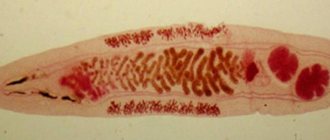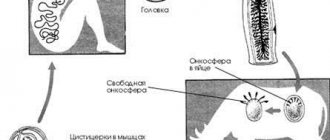The structure of a wide tapeworm
A sexually mature worm consists of three segments - head, neck, tail. The head part of the parasite is small in size - its length is 1 mm and its width is 3-5 mm. Elongated, slightly compressed on the sides, it has slit-like grooves that allow the wide tapeworm to attach to the intestine. Behind the head there is a thinnest neck. Wide segments extending from it contain the reproductive organs of the helminth (an adult worm can have more than 3000 of them). The eggs of the parasite are oblong in shape (resemble a regular egg). At one end there is a cap for the larva to emerge, and at the other there is a small tubercle. The broad tapeworm, like other tapeworms, has such a feature as the presence of male and female reproductive organs. The uterus with the ovaries of the parasite is located in the central part of the segments, the testes and vitelline sacs are located on the side. A duct for removing sperm departs from the testes, located at the bottom of each segment, opening outward in its anterior region. In addition to this opening, each segment of the parasite has two more - the vagina and the uterus. The vagina of the wide tapeworm opens in close proximity to the vas deferens and, together with it, creates an apparatus for copulation located in a pouch of muscles. The segments of the worm mate both crosswise and within one segment. The reproduction process of the broad tapeworm begins when there are sixty or more segments. The parasite is capable of laying about 1,000,000 eggs per day.
Who is the wide tapeworm?
Diphyllobothrium latum is a tapeworm ranging from 2 to 10 meters in length. Some specimens exceed this length. The wide tapeworm belongs to the class of cestodes (Cestoda), family Diphyllobothriidae. It consists of a neck, on which there is a scolex (head) with two slit-like devices for attaching the helminth to the mucous membrane of the small intestine, and a body.
The body of the tapeworm consists of a huge number of segments, their number reaches 4 thousand. Large oval-shaped eggs are formed in mature segments. They are protected by a two-layer shell and have a cap on one of the poles. While in the intestines of the intermediate or definitive host, the tapeworm secretes immature eggs that reach full maturity only in fresh water.
Life cycle
The life cycle of the broad tapeworm is quite complex. From the intestines of the definitive host, worm eggs located in the final segments are excreted together with feces. Once out, they are purified and end up in fresh water bodies. 16 days after leaving the host body (subject to certain conditions), the parasite embryo, which has six hooks, crawls out of the egg. If the water temperature does not exceed plus 15 °C, the wide tapeworm does not develop, however, it remains viable for six months. When the embryo is swallowed by daphnia or cyclops, it transforms into a procercoid, about 0.5 mm in size. The transformation process of the parasite takes 2-3 days.
Fish become infected by ingesting infected crustaceans. The larvae of the worm enter their muscle tissue and organs, and after 3-4 weeks they turn into plerocercoids - creatures about 4 cm long with a finally formed head, prepared for relocation into the body of the final host, which is infected after consuming fish. Attention! In the vast majority of cases, crustaceans are consumed by small fish. However, it, in turn, serves as food for predators - pike, trout, perch, pike perch. In such situations, the parasite larvae move into the muscle tissue of predatory fish, which also becomes infective. In the body of the definitive host, the worm first transforms into an immature adult, and then into a mature one, living in the small intestine (from this moment eggs appear in the feces). As a rule, the formation process takes 2-4 weeks. The life span of a worm can reach 20 years.
The broad tapeworm (Diphyllobotrium latum) is one of the largest human parasites, reaching a length of up to 10 m or more. The head, or scolex, is 3-5 mm in size, oblong-oval in shape, flattened on the sides and has two longitudinal suction slits (bothria) on its narrow sides, with which the tapeworm is attached to the intestinal wall. Eggs are up to 75 microns long, gray or yellowish in color. The broad tapeworm parasitizes the small intestine of humans, dogs, pigs, and some wild animals that feed on fish. The eggs are released in feces and must be released into a body of water for further development. There the larva (coracidium) matures in the eggs. Coracidia are swallowed by freshwater crustaceans - cyclops, and the latter - by fish. In the body of fish, larvae (at this stage they are called plerocercoids) accumulate in the muscles and internal organs, especially in the eggs. The most commonly infected species are pike, ruffe, burbot, and perch. The plerocercoids are whitish-milky in color, from 1 to 25 mm long, and have a head with bothria. When eating insufficiently cooked fish, lightly salted caviar, or stroganina, the larvae turn into adult tapeworms in the human intestine within 2 months. The lifespan of the parasite reaches 10 years. The broad tapeworm is the causative agent of the disease diphyllobothriasis. The diagnosis is based on the detection of tapeworm eggs in the feces. Often, fragments of tapeworm strobila are isolated from patients with feces. Prevention. Workers, river transport workers, and residents of coastal villages are examined in a laboratory with mandatory treatment of identified patients. It is important to properly thermally process fish.
Rice. 4. Wide tapeworm: life cycle (left) , sexually mature individual (right) .
Pork tapeworm
The pork, or armed, tapeworm Taenia solium reaches a length of no more than 3 m. On the head with a diameter of 0.6-2 mm, in addition to 4 suckers, there are 22-32 hooks. Mature segments contain about 50 thousand eggs, the uterus has 8-12 lateral branches. The joints do not have active mobility. Oncospheres of pork and bovine tapeworms are practically indistinguishable. Pork tapeworm parasitizes the small intestine of humans (for several years). The segments are released into the environment with feces. If oncospheres are ingested by pigs, then fins develop in the muscles of these animals. A person becomes infected by eating Finnish pork meat that has not undergone sufficient heat treatment. In some cases, a person can become infected with oncospheres - through the mouth from a patient or through self-infection (autoinvasion) when oncospheres enter the stomach from the intestines during vomiting, as well as by eating unwashed vegetables grown by fertilizing the soil with unrecovered sewage. As a result of human infection with pork tapeworm oncospheres, fins (cysticerci) can develop in the subcutaneous tissue, muscles, eyes, and brain, causing a serious disease - cysticercosis . Adult pork tapeworm causes the disease taeniasis . For diagnostic purposes, examination of segments released with human feces and stool microscopy are used. In this case, it is necessary to differentiate taeniarinhoz (a disease caused by bovine tapeworm) and taeniasis. The diagnosis of cysticercosis is made on the basis of clinical, radiological and laboratory data. Prevention. Mandatory treatment of identified patients. Personal hygiene is important. The environment should not be contaminated with human feces and pigs should not have access to them. The population is explained the dangers of unsupervised backyard slaughter of pigs and the advisability of veterinary and sanitary examination of meat. Meat, especially meat that has not passed veterinary control, should be thoroughly cooked. Finns die if the meat is frozen to a temperature of –12°C or boiled for at least 2 hours.
Rice. 5. Pork tapeworm: life cycle (left) , sexually mature individual (right) .
Dwarf tapeworm
Dwarf tapeworm (Hymenolepis nana) 0.5 - 5 mm long. Consists of a ribbon-like body (strobili), neck, head. The head has 4 suckers and 20-30 hooks in the form of a crown, with which the tapeworm is attached to the intestinal wall. The mature end segments are almost completely filled with eggs; when the segments are destroyed, many of the latter end up in the feces in the intestine. The eggs are oval or round in shape, transparent, colorless. The shell is thin, double-circuit. The dwarf tapeworm parasitizes the small intestine of humans, often in hundreds and even thousands of copies, and in some cases in the intestines of rodents. The eggs are shed in the stool of an infected person. If the rules of personal hygiene are violated, eggs can end up on door handles, pots, toys, contaminate hands, and be carried by hands and flies onto food. Through the mouth, the eggs enter the intestines. Here the oncospheres are freed from the membranes and penetrate the villi, where they turn into larvae (cysticercoids). After 4-6 days, cysticercoids destroy the villi and fall into the intestinal lumen, then attach to the intestinal wall and within a week turn into an adult tapeworm. Eggs can enter the intestinal lumen directly from the tapeworm segments. Therefore, in a number of cases, intraintestinal “self-infection” (autoinvasion) occurs, or more precisely, repeated “self-infection” (autosuperinvasion) without the release of eggs into the environment. The disease caused by the dwarf tapeworm, hymenolepiasis , is characterized by a disorder of the digestive and nervous system. Diagnosis. The main method is stool microscopy to detect eggs. Prevention. Hymenolepiasis is widespread. Laboratory examination of children and staff of preschool institutions and schoolchildren. When identifying patients with hymenolepiasis, all family members are examined. Requirements for the sanitary regime must be especially carefully observed during the deworming period. Children must observe the rules of personal hygiene and clean thoroughly.
Rice. 6. Dwarf tapeworm.
BIOLOGICAL FEATURES OF PARASITES TYPE ROUNDWORMS
Class Nematodes
- Body cylindrical, unsegmented; The cross section of the body is a circle.
- Primordial animals.
- The outside is covered with a complex multi-layered cuticle.
- Digestive system: a tube stretching through the entire body, at the anterior end of the mouth, then the pharynx, esophagus, mid and hind intestines, outlet.
- Nervous system: peripharyngeal nerve ring, from which nerve trunks extend forward and backward, connected by commissures.
- Excretory system: unicellular skin glands; excretory products are excreted through the lateral channels.
- The circulatory and respiratory systems are absent.
- Reproductive system. Nematodes are usually dioecious and for the most part have clear sexual dimorphism.
Development . Most nematodes lay eggs, but there are also viviparous forms. The life cycle of most is relatively simple: there is no alternation of generations. The laid eggs or larvae are hatched, and for further development they must enter another individual of the same host animal species. There are, however, many species of nematodes in which part of their life cycle takes place in the body of an intermediate host. Diseases caused by nematodes are called nematodes .
Mechanism of infection
When they enter the host's gastrointestinal tract, the parasite larvae reach the large intestine and then attach to its walls using suction cups. As a result, the intestinal walls are pinched, ulcerations form, and the mucous membrane is injured, which is accompanied by atrophy. Attention! The penetration of a large number of worms into the body, as well as the growth of a wide tapeworm to an impressive size, is fraught with the development of intestinal obstruction, requiring immediate surgical intervention.
Routes of entry into the human body
Broad tapeworm infection usually occurs when eating raw or improperly cooked fish. The parasite larvae living in rivers and lakes are not dangerous to humans and animals. When they penetrate the body, they mostly die without transforming into a full-fledged worm. Attention! In order for the parasite to survive, it needs to go through all larval stages in intermediate hosts. Thus, it is impossible to become infected from a sick person or representative of the fauna, as well as to become infected with the tapeworm yourself. Another route of infection with the parasite is considered to be contact with sick fish during cutting. That is why it is advisable to work with it in rubber gloves, and wash the knife and cutting board with hot water and disinfectant.
Routes of infection
Parasites occur in large numbers in areas where there are many bodies of water.
More often, people living in the following European countries suffer from invasion: the Baltic states, Ireland, Switzerland. Also, cases of detection of invasion occurred in Israel, Japan, and North America. This is due to an increase in the number of emigrants from European countries. Humans become infected by eating raw or half-raw fish, as well as by violating the rules of personal hygiene, for example:
- If a person works with fish and does not wash his hands well after finishing work.
- If you try a piece of undercooked fish while cooking.
- If, after cutting the fish, the utensils or cutting boards are used further for other purposes.
Important: it is impossible to become infected with this disease through sexual contact, kissing or close contact with a carrier of the disease. Infection from pets is also impossible. The larvae of the broad tapeworm, which live in various bodies of water, are absolutely safe for humans.
An adult worm has a special structure and consists of the following parts:
- Scolex, that is, the head.
- Proliferative region (neck).
- Lower body.
Each side of the head has special slit-like grooves called bothria, their purpose is to attach to the intestines.
Symptoms
In the vast majority of cases, patients experience an asymptomatic or mild form of diphyllobothriasis (pathology caused by infection of the broad tapeworm). However, in this case, the appearance of segments of the parasite in the feces is observed. In the case of an obvious course of the disease, the main manifestations appear after approximately two months. A person infected with worms experiences:
- abdominal pain resembling cramps;
- increased salivation;
- nausea;
- appetite disorders - its increase, alternating with a complete lack of desire to eat any food;
- losing weight with proper nutrition;
- anemia;
- inflammation of the tissues of the tongue (glossitis).
Immediately after the wide tapeworm enters the intestines, disorders of the digestive processes are observed. Then pain appears after eating. With severe helminthic infestation, the size of the liver and spleen increases. Prolonged presence of tapeworm in the body is accompanied by symptoms of anemia:
- weakness;
- decreased performance;
- increased heart rate;
- pain and dizziness;
- hypotension;
- paleness of the skin;
- fainting states.
The main cause of anemia lies in the lack of vitamin B12, which is involved in the production of hemoglobin. During the same time period, a person infected with tapeworm develops symptoms of a central nervous system disorder:
- paresthesia;
- numbness;
- nervousness and irritability;
- ataxia;
- depressed mood.
Symptoms of diphyllobothriasis
From the moment the tapeworm enters the human body until the first significant symptoms appear, it can take from 20 to 60 days. Manifestations of the disease develop gradually and may be mild for a long time.
Symptoms of infection:
- Nausea, vomiting;
- Abdominal pain of a cramping nature;
- Increased salivation (hypersalivation);
- Fatigue;
- A slight increase in temperature to subfebrile levels;
- Decreased or increased appetite, weight loss;
- Alternating constipation and diarrhea;
- The appearance in feces of fragments of the body of the tapeworm in the form of scraps of whitish ribbons;
- Intestinal obstruction due to the accumulation of helminths in the lumen of the small intestine;
- Signs of anemia with vitamin B12 deficiency (weakness, tachycardia, dizziness, pale skin, swelling of the face, arms and legs, cracked tongue, atrophy of taste buds, damage to the oral mucosa);
- Damage to the nervous system (numbness of the limbs, sensory disturbances, unsteady gait);
- Blood composition disorders (decrease in the number of leukocytes, erythrocytes, platelets, blood hemoglobin, increase in color index, appearance of megaloblasts, megalocytes).
The intensity of symptoms depends on the degree of damage to the body, concomitant pathologies, and diet. In severe cases, hepatomegaly, enlarged spleen, and extremely low secretion of gastric juice are noted. The accumulation of many helminth individuals in the intestinal lumen leads to obstructive intestinal obstruction. There are cases of latent (hidden) infection.
Methods of getting rid of the parasite
Treatment of helminthiasis caused by infection with the broad tapeworm is carried out after a thorough examination of the patient, passing all the required tests and making a diagnosis (diagnosis is carried out within the walls of specialized medical clinics). Patients are prescribed anthelmintic drugs. In some cases, treatment can be supplemented with traditional medicine. There are no other ways to get rid of parasites.
Use of drugs
Treatment of broad tapeworm is carried out by ingesting medications such as Fenasal or Biltricide. The medications are taken strictly as prescribed by the doctor and according to the regimen developed by him. This is explained by the fact that the uncontrolled use of such drugs against parasites can cause the development of serious side effects (anthelmintic drugs are very toxic not only for parasites, but also for people). If patients show signs of anemia, they are recommended vitamin B12 or cyanocobalamin in the dosage prescribed by the doctor per week for one to one and a half months. In addition to this, iron-based drugs are prescribed that improve hemoglobin levels (Ferronal, Ferroplex, Hemofer, Ferrum Lek). Therapy is also carried out to get rid of the manifestations of the disease. In the vast majority of cases, treatment is aimed at eliminating the symptoms that develop when the gastrointestinal tract and central nervous system are damaged due to the vital activity of parasites. Patients are prescribed sorbents, probiotics, enzymes, painkillers and medications that support the liver.
Folk remedies
Traditional medicine is used as a complement to the main treatment and can significantly speed up recovery. The following herbal preparations for parasites, approved for use at home, are recommended for sick people.
- Male fern fruit extract. Treatment is carried out as follows. In the evening before going to bed, take a laxative tablet, do a cleansing enema in the morning before meals, and then drink an anti-parasite remedy every two minutes (the number of gelatin capsules is determined by the doctor). After half an hour, drink the laxative again, and then have breakfast (breakfast should be light). If after three hours there is no bowel movement, an enema is given again to cleanse the intestines of parasites.
- Pumpkin seeds. Three hundred grams of pumpkin seeds are poured with sixty heated water, crushed and consumed on an empty stomach (you need to eat the seeds within an hour). After three hours, they drink a laxative, and after half an hour, they cleanse the intestines with an enema.
- Sagebrush. Contains phytoncides, substances that lead to paralysis of the larvae and inhibit the overall activity of the broad tapeworm. To prepare a remedy for parasites, take a small spoon of wormwood, cloves and flax, chop it, pour it with a liter of freshly squeezed carrot juice. Drink immediately after waking up and while eating.
- Onion. It is used both internally and for preparing enemas. In the first case, two medium-sized onions are chopped, filled with 400 milliliters of water and left for 12 hours in a cool place. The finished infusion is drunk on an empty stomach for five days. In the second, a tablespoon of onion peel is mixed with an equal amount of crushed wormwood, poured with a liter of water, stirred, put on fire and brought to a boil. The parasite remedy is then filtered through cheesecloth. The enema is given twice a day for four days.
Treatment
Despite changes in the chemical composition of the blood, diphyllobothriasis (infection with a broad tapeworm) is more often diagnosed by analyzing stool for the presence of helminth eggs. In some cases, patients at home notice the presence of a worm in their stool and report this to the doctor during a consultation interview. The prescription of treatment depends on the general condition of the patient and is prescribed for each patient separately.
The main treatment regimen is based on the use of antiparasitic drugs to remove the broad tapeworm from the body. The following medications are used: “Fenasal” or “Niclosamide” - a single dose in a dose of 1 to 3 grams. "Biltricid" is also prescribed once, the average dosage is 25 milligrams per 1 kilogram of the patient's body weight.
We invite you to familiarize yourself with Bugs in cereals or flour: photos, how to get rid of them and what to do
When the first symptoms of diphyllobothriasis appear, you must consult a doctor who can make a diagnosis based on the results of a pre-conducted diagnosis. To begin with, the doctor collects anamnesis, asking about symptoms and their duration, about possible routes of infection. Further, if necessary, he prescribes diagnostics, which may contain:
- Stool analysis.
- General blood test.
- Serological testing for antibodies.
- Examination of stool to detect parasite eggs or segments.
- Blood test for vitamin B12.
- Colonoscopy.
- Blood chemistry.
In some cases, if in doubt, an ultrasound examination of the internal organs of the abdomen and computed tomography are prescribed. Only based on the test results can the doctor prescribe the necessary treatment and make an accurate diagnosis.
If a parasitic worm is detected in the human body, treatment is prescribed immediately and must be carried out under the supervision of a doctor.
Mostly, drugs are prescribed that cause muscle spasms in parasites. These drugs contain praziquantel, and Fenasal is also very often used. The treatment regimen must also include:
- Folic acid.
- Multivitamins that include various B vitamins, and intramuscular injections of vitamin B12 are also recommended.
- Probiotics are recommended to restore normal flora of the gastrointestinal tract.
- A special diet requires that you exclude various starchy foods and sweets from your diet.
- Very often, a relapse of the disease is possible, so six months after the end of treatment, it is necessary to undergo control tests.
The use of traditional methods of treatment is allowed only after prior consultation with a doctor and his consent.
The following method is very popular: at 2 am you need to drink 100 g of cognac, and then castor oil (if possible) and then you need to go to the toilet. This procedure is carried out over the course of a week, and it allows you to get rid of not only the broad tapeworm, but also many other parasitic organisms living in the intestines and stomach.
We suggest you familiarize yourself with Symptoms of worms in humans at home
It is also believed that pumpkin seeds are a good and effective preventive method that reduces the risk of worms.
Traditional medicine recommends the use of the following products that have a positive effect on the treatment of diphyllobothriasis and help get rid of parasites living in the human body:
- Fresh onions and garlic.
- Grated radish with horseradish, seasoned with vegetable oil.
- Pomegranates, tincture made from pomegranate peel is especially effective.
- Coconut pulp and juice are recommended to be consumed 4 hours before meals.
- Sauerkraut brine.
Preventive measures
Measures to prevent broad tapeworm infection include:
- use of protective gloves when preparing fish dishes;
- prevention of eating poorly salted, fried or boiled fish.
The death of parasite larvae occurs at a temperature of minus 55 °C. To avoid infection caused by their penetration into the body, fish should be fried for 10 minutes on each side, and large pieces for half an hour. When salting, the salt content in the finished product must be at least 9%. If infection does occur, you should immediately begin treatment, and after its completion, conduct a follow-up examination. This is explained by the fact that in some cases the therapeutic effect is not achieved immediately. The head of the parasite remains on the intestinal mucosa, and then, after some time, begins to produce segments and eggs again. In this case, repeated therapy is prescribed to completely destroy the broad tapeworm. It is necessary to treat diphyllobothriasis.
How does infection occur?
What routes of infection lead to dangerous helminthiasis? Most often this is the consumption of dishes made from raw (stroganina, balyk) or poorly prepared fish, poorly salted caviar and the liver of freshwater fish. Poor temperature treatment preserves the larvae of the tapeworm and can lead to disastrous results - after all, there is always a risk that the fish is infected with a helminth. In addition, one should not lose sight of the possibility of plerocercoids getting into food through contact with infected fish during cutting, from the surface of poorly treated cutting boards and utensils, or when storing raw and cooked food together.
The main route of invasion is food. More often, one sexually mature individual of the parasite develops in the intestines of a sick person, less often - several. As a rule, due to eating habits, adults get sick more often than children. If the question arises whether to eat untested fish caught from fresh water, it would not hurt to pay attention to such risk factors as:
- the presence of crustaceans in a nearby body of water;
- the fish was caught in shallow water;
- low sanitary and hygienic condition of the reservoir;
- poor heat treatment of a fish dish.
If you have the slightest doubt about the quality of fish products, then you should not risk the health of yourself and your loved ones. It is better to be overly cautious than to pay for carelessness with an unpleasant disease.










